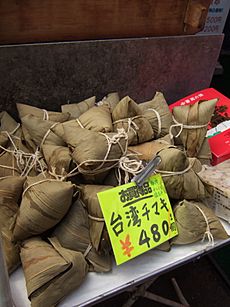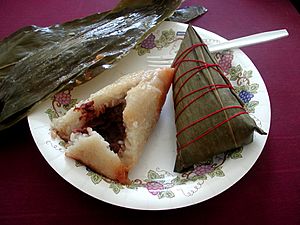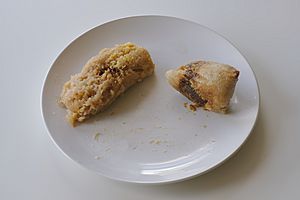Zongzi facts for kids

A bunch of rice dumplings tied together with twine
|
|
| Alternative names | bakcang, bacang, zang, nom asom, Pya Htote , "Joong", "Doong" |
|---|---|
| Type | Rice cake |
| Place of origin | China |
| Region or state | Chinese-speaking areas |
| Main ingredients | Glutinous rice stuffed with different fillings and wrapped in bamboo or reed leaves |
| Variations | Chimaki, Lotus leaf wrap |
| Similar dishes | Mont phet htok |
| Zongzi | |||||||||||||
|---|---|---|---|---|---|---|---|---|---|---|---|---|---|
| Chinese | 粽子 | ||||||||||||
|
|||||||||||||
| Cantonese name | |||||||||||||
| Chinese | 糉 | ||||||||||||
|
|||||||||||||
| Southern Min name | |||||||||||||
| Traditional Chinese | 肉粽 | ||||||||||||
|
|||||||||||||
Zongzi (Chinese: 粽子) is a traditional Chinese rice dish. It is made of glutinous rice (sticky rice) filled with different tasty ingredients. These are wrapped in large leaves, usually bamboo or reed leaves. Zongzi are cooked by steaming or boiling. In many Western countries, they are often called rice dumplings or sticky rice dumplings.
Contents
Different Names for Zongzi
As zongzi became popular across Asia, it got many different names.
- In Myanmar, it's called Pya Htote.
- In Cambodia, it's Nom Chang.
- In Philippines, it's Machang.
- In Indonesia, it's Bachang.
- In Laos, it's Khanom Chang.
- In Thailand, it's Ba-chang.
Vietnamese cuisine has a similar dish called Bánh ú tro or Bánh tro. In places like Malaysia, Indonesia, Singapore, and Taiwan, zongzi is often known as bakcang, bacang, or zang. This comes from the Hokkien Chinese language. In the United States, especially in California and Texas, some people call zongzi "Chinese tamales".
In Mauritius, zongzi is a traditional dish. It is eaten by people of Chinese origin. It is especially popular during the Dragon Boat Festival. This festival remembers the death of a famous poet named Qu Yuan.
Zongzi and the Dragon Boat Festival
Zongzi are a special food for the Duanwu Festival. This festival is also known as the "Dragon Boat Festival" in English. It happens on the fifth day of the fifth month of the Chinese lunar calendar. This usually falls between late May and mid-June each year.
The Story Behind Zongzi
Many Chinese people believe zongzi are eaten to remember Qu Yuan. He was a famous poet from the ancient kingdom of Chu. Qu Yuan was very patriotic and tried to help his king. But when his advice was not heard, he drowned himself in the Miluo River in 278 BC.
People at that time admired Qu Yuan's talent and loyalty. So, they threw rice dumplings into the Miluo River every year. They hoped the fish would eat the dumplings instead of Qu Yuan's body.
The story of zongzi being linked to Qu Yuan became popular much later. By the 6th century AD, people widely connected zongzi with the Double Fifth Festival and Qu Yuan.
One old story says that Qu Yuan's ghost appeared to a man named Ou Hui. The ghost told him to wrap the rice packets with special leaves and colored string. This would keep dragons from eating them. This fable was written down centuries after Qu Yuan's death.
Another part of the legend says that locals rushed out in dragonboats to find Qu Yuan's body. They threw rice packets into the river to keep the fish away from him.
A Brief History of Zongzi
People have been eating zongzi around the Double Fifth Festival since the 2nd or 3rd century AD.
- In the late Han dynasty, people made zong by wrapping sticky rice in leaves. They boiled them in water mixed with wood ash. These early zong were sometimes called jiao shu, meaning "horned millet," because of their cone shape.
- In the Jin dynasty (266–420 AD), zongzi became an official food for the Dragon Boat Festival.
- During the Northern and Southern dynasties, zongzi started to have more fillings. These included meat, chestnuts, and red beans. People would give them as gifts to family and friends.
- In the 6th century, some zongzi were made in "young bamboo" tubes. They were eaten during the Summer Solstice.
- By the Tang dynasty, zongzi came in conical and diamond shapes. The rice was very white.
- In the Northern Song Dynasty, zongzi with glacé fruit became popular. There were even special shops selling zongzi.
- During the Yuan and Ming dynasties, the wrapping leaves changed. More fillings were used, like bean paste, pine nut, pork, and walnut.
- In the Qing dynasty, zongzi became a symbol of good luck. Students taking important exams would eat "pen zongzi." These looked like a writing brush and sounded like the Chinese word for "pass." This was a good omen for their exams. Ham zongzi also appeared during this time.
Even today, every year in early May of the lunar calendar, Chinese families soak sticky rice and wrap zongzi. There are now many different types of zongzi.
What Zongzi Look Like
The shapes of zongzi can be different. In southern China, they are often shaped like a pyramid. In northern China, they might be long and cone-shaped. Wrapping zongzi neatly is a skill often passed down in families. Making zongzi is a traditional family activity where everyone helps.
Most zongzi are wrapped in bamboo leaves. But in other countries, people might use leaves from lotus, reed, maize, banana, or pandan plants. Each type of leaf adds its own special smell and taste to the rice.
The fillings inside zongzi also change from place to place. But the rice is almost always glutinous rice, also known as "sticky rice." Sometimes the rice is lightly cooked or soaked before it's used.
Sweet and Savory Fillings
- In northern China, zongzi fillings are usually sweet. Popular choices include red bean paste, tapioca, taro, or jujube dates. These zongzi are often like a dessert.
- In southern China, zongzi are usually savory or salty. Common fillings include ham, salted duck egg, pork belly, shredded pork or chicken, Chinese sausage, and shiitake mushrooms.
Zongzi need to be steamed or boiled for several hours. The cooking time depends on how the rice and fillings were prepared. Today, you can find all kinds of zongzi in markets. Their types are not limited to where they first came from.
Common Zongzi Fillings
- Mung beans
- Red bean paste
- Chinese sausage
- Jujube
- Salted chicken fat
- Mushrooms
- Chinese black mushrooms
- Salted eggs
- Ham
- Hard boiled eggs
- Nuts
- Chestnuts
- Cooked peanuts
- Pork
- Conpoy (dried scallops)
- Red-cooked meats
- Chicken
- Yam
- Vegetables
- Lotus seed
Types of Zongzi
There are many different kinds of zongzi across China and other countries.
Zongzi in China
- Jiaxing zongzi (嘉兴粽子): These are famous in mainland China. They are named after the city Jiaxing. They usually have pork filling, but can also have mung beans, red beans, or salted duck eggs.
- Jianshui zong (碱水粽): These are "alkaline water zong." They are usually eaten as a dessert. The sticky rice is treated with a special water that makes them yellow. They often have no filling or a sweet filling like sweet bean paste. People often eat them with sugar or light syrup.
- Cantonese jung (广东粽): These are a type of southern zongzi. They often have fresh meat like chicken, duck, or char siu pork. Cantonese jungs are small and shaped like an awl (a pointed tool).
- Banlam zang (闽南粽): These pork dumplings are very famous in Xiamen and Quanzhou. They have braised pork belly, mushrooms, and shrimp.
- Sichuan zong (四川粽): People in Sichuan like spicy food. So, their zongzi are spicy! They add Sichuan peppercorns, chili powder, and a little preserved pork. They are cooked and then roasted, making them tender and flavorful.
- Beijing zong (北京粽): These are the sweetest zongzi. They use red dates, bean paste, or even preserved fruit as filling. They are often eaten cold, especially in summer, and taste even better after being in the refrigerator.
Zongzi in Taiwan
- Northern Taiwanese zongzi (北部粽): These are wrapped in Phyllostachys makinoi bamboo husks and then steamed.
- Southern Taiwanese zongzi (南部粽): These are wrapped in Bambusa oldhamii leaves and then boiled.
- Vegetarian zongzi in Taiwan are made with dry peanut flakes.
- Meat-filled zongzi in Taiwan can have fresh pork, chicken, duck, egg yolk, mushroom, dried shrimps, or fried scallions.
Zongzi in Mauritius
- Sweet zong: This zongzi has plain rice (no fillings). It is eaten with crushed peanuts and sugar.
- Salty zong: This one has meat, beans, and other fillings mixed into the rice.
Zongzi in Singapore and Malaysia
- Nyonya chang (娘惹粽): This is a special zongzi from Peranakan cuisine. It is made similarly to southern zongzi. The filling is usually minced pork with candied winter melon, roasted peanuts, and a mix of spices.
Gallery
- Variations of zongzi
See also
 In Spanish: Zongzi para niños
In Spanish: Zongzi para niños






